Menu
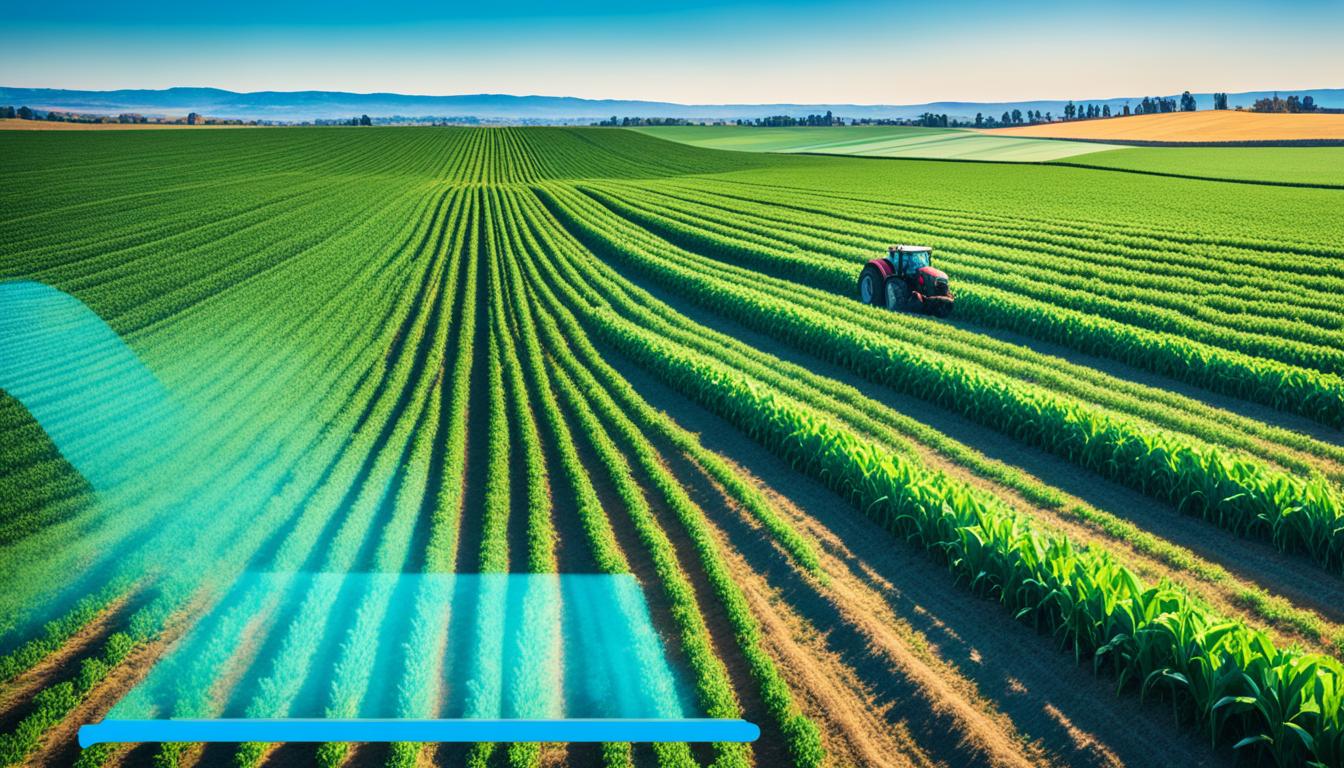
Did you know that by 2026, the global connected agriculture market could be worth USD 7.22 billion? In 2018, it was valued at USD 1.84 billion. This growth, at a rate of 19.1% yearly, is changing agriculture globally.
It’s doing more than just getting bigger. It’s changing farming by using new technology and ideas. This helps meet demands and solve modern problems.
COVID-19 and geopolitical events have affected this market a lot. Our look at the market will cover its size, what it includes, the new tech, and how things get done.
North America was the biggest in the market in 2018, making USD 626.7 million. It’s now set to reach USD 2,353.9 million by 2026. Its lead comes from using the best tech and embracing connected agriculture.
The competitive side is key too. Companies like GAMAYA, Iteris, Inc., and IBM are making big moves in connected farming. Solutions are the top choice now. They help farms produce more, handle money better, and watch over animals well.
Today, the agriculture world is changing fast. New tech and a push for eco-friendly methods are leading this change. Smart farming tools and technologies are creating a new era in agriculture. So, let’s explore some top trends remaking farming.
Farming is using high-tech methods to be more efficient and productive. IoT lets farmers check on their crops and animals instantly. This technology is big in places like India, the US, and Western Europe, showing its global reach.
Robotic farming, which includes picking, planting, and caring for animals, is on the rise too. AI gives farmers weather updates, crop forecasts, and more. This helps them make better decisions. Also, farming with precision and indoors is becoming more common. Big investments in AgriTech are driving this change. Companies like Plantagon and Indoor Harvest are leading, making farming smarter.
Farming is moving towards methods that are good for the earth and keep up the yield. This includes vertical and indoor farming, which are new and smart ways to grow crops. A close look at agriculture innovation shows 10 trends that will shape farming by 2024.
AeroFarms and Green Sense Farms are making big steps in eco-friendly farming. They are using advanced methods to save resources and grow more food. The Tree Map highlights the top 10 trends in farming. It shows a bigger focus on green farming to feed the world. The farm market will get bigger, thanks to these green solutions, supporting more growth in agriculture.
The outlook for crop prices is changing because of many things. This includes market fluctuations, the environment, and challenges in the supply chain. By exploring these factors, we get a clearer view of what to expect in crop prices.
*Crop price drivers* are making big changes in *agricultural commodities forecasting*. For example, the production and export of crops like corn, soybean, and cotton could hit new highs by 2032/33. Although there was a slight drop in the total crop planting area to 249.5 million acres, each crop shows different planting trends.
For instance, corn planting is expected to grow to 92.0 million acres next season, then it will slightly fall to 89.0 million acres by 2032/33. But, soybean and wheat planting may slightly decrease by 2032/33 even after some growth periods.
The changes in plantings have a big effect on prices. Corn is estimated to cost $4.30 per bushel by 2026/27 because of new demands in ethanol. Soybean prices will also even out at $10.30 per bushel after an initial drop. Wheat prices, likewise, will level at $5.70 from the high point seen in 2022/23.
Looking at crop prices by region gives more details. In North America, corn prices will stabilise. This is because of more exports, expected to reach 2.7 billion bushels by 2032/33. There will be improvements in soybean crush and wheat exports too, reflecting a strong global demand.
In APAC, prices might be affected by competition. Local producers will change to meet market needs and different weather effects. The region’s reliance on imports will play a big role in price changes.
Europe is looking at higher wheat prices. Things like continuous climate changes and new farming policies are driving this. On the other hand, the Middle East and Africa could face more unpredictable prices. This is due to changes in trading policies and world tensions.
Overall, prices will shift a lot between regions. This is because of the many factors at play in *crop price drivers* and *agricultural commodities forecasting*. It’s important to look at the bigger economic and environmental story to understand where the market is heading.
| Crop | 2023/24 Projection | 2032/33 Projection | Price Stabilisation |
|---|---|---|---|
| Corn | 92.0 million acres | 89.0 million acres | $4.30 per bushel |
| Soybean | 87.0 million acres | 86.5 million acres | $10.30 per bushel |
| Wheat | 47.5 million acres | 46.0 million acres | $5.70 per bushel |
The market for intelligent agriculture is getting better every day. Big names like Trimble, John Deere, AGCO, and Ag Leader Technology lead the way. They bring new ideas and tools to farming to make it more sustainable.
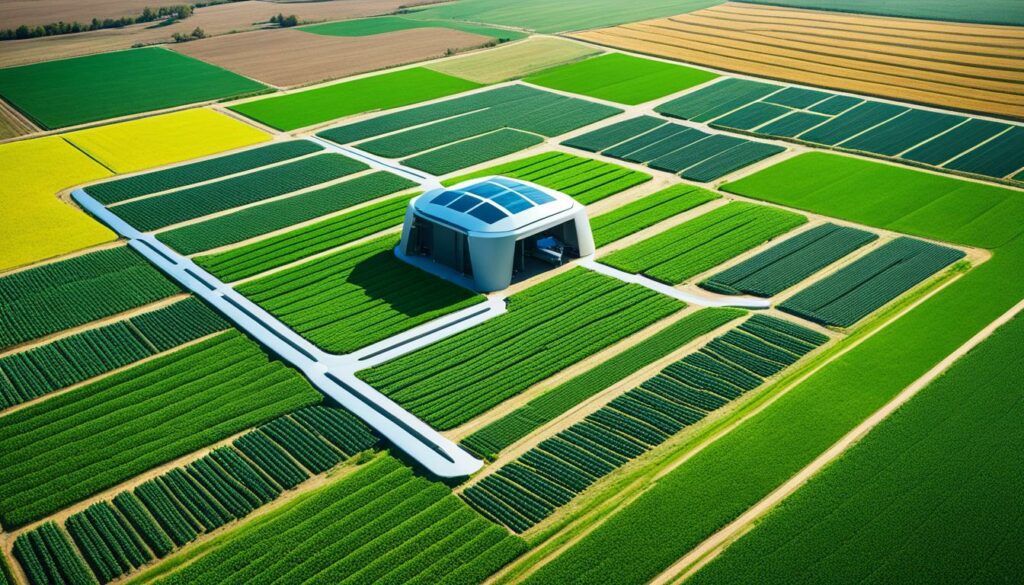
Trimble, John Deere, AGCO, and Ag Leader Technology are the top players. They use the latest tech to improve farming, monitoring the soil and watering. Their work helps meet the world’s need for farming that’s both efficient and eco-friendly.
To know the intelligent agriculture market’s position, we look at a SWOT and PESTLE analysis. They show what’s good (innovations and full farm systems), and what’s not so good (costs and rules).
PESTLE looks at outside stuff like the economy, tech changes, and green rules that affect the market.
In 2021, the smart agriculture market hit USD 8177.29 million. It’s expected to hit USD 18582.47 million by 2027. This is a 14.66% increase every year. The use of smart farm tech is going up, meaning the market looks bright from 2023 to 2030.
Right now, hardware is the market’s biggest part. But, from 2024, software is predicted to grow the most.
Global Smart Agriculture Market Insights:
| Year | Market Size (USD Million) | CAGR (%) |
|---|---|---|
| 2021 | 8177.29 | 14.66 |
| 2023 | 22650.00 | 13.7 |
| 2027 | 18582.47 | – |
Intelligent agriculture has a lot of room to grow. It’s seen in areas like better crop monitoring, keeping an eye on animals, and using smart greenhouses. A careful SWOT analysis and keeping an eye on market growth is key for anyone wanting to be part of the success.
The world’s livestock market changes a lot thanks to new tech and how farming is done. Inside the livestock market report, we see tech for keeping tabs on animals is getting more important. This is changing the livestock industry in big ways.
Recently, more farmers are using tech to watch over their animals. This has made the market grow a lot. The size of the global livestock monitoring market in 2022 was USD 5.6 billion. By 2032, it’s expected to reach USD 23.35 billion. That’s a huge increase!
In 2022, the biggest chunk of money went to the tools and gadgets needed for this tech. But, the software part is catching up fast, getting 18.2% more important by 2032. With different animals, poultry farming is set to grow the quickest by 18.6% each year.
Dairy farms are also using more monitoring tech, thanks to higher milk demands. North America leads the way in the market, with over 33% of it in 2022. The U.S. and Canada are using the latest tech in farming.
Prices of livestock items change because of lots of reasons. In January 2024, there were 87.2 million cattle and calves in the U.S. This is 2% less than 2023, the lowest since 1951. Other livestock numbers are also down, showing tough times.
In December 2023, beef making went down by 2% from the year before. But, the size of the meat from each animal was at an all-time high of 849 pounds. People are more willing to pay for beef, although they might slow down due to higher prices. The demand for U.S. beef worldwide is also facing issues, with exports down 14% by November 2023.
Corn prices are expected to drop in 2024, with the average predicted to be $4.80. This is less than what farmers got in the past two years. But, farming is getting more expensive. Interest rates for farmers went up by 43%, making it harder to grow more cattle.
The future of the livestock market is full of change. Knowing about these price changes is key for anyone involved. It helps in making smart choices for the future.
| Category | 2022 | 2024 (Forecast) | CAGR (%) |
|---|---|---|---|
| Livestock Monitoring Market Size (USD Billion) | 5.6 | 23.35 | 15.4 |
| Hardware Components Revenue Share (%) | 42.0 | N/A | N/A |
| Software Segment Growth Rate (%) | N/A | N/A | 18.2 |
| Poultry Growth Rate (%) (Forecast) | N/A | N/A | 18.6 |
| North America Market Share (%) | 33.0 | N/A | N/A |
| U.S. Cattle and Calves (Millions) | N/A | 87.2 | -2.0% |
The agribusiness sector is both challenging and promising. It plays a key role in feeding the world and supporting rural communities. However, it grapples with many challenges that need addressing to keep growing sustainably.
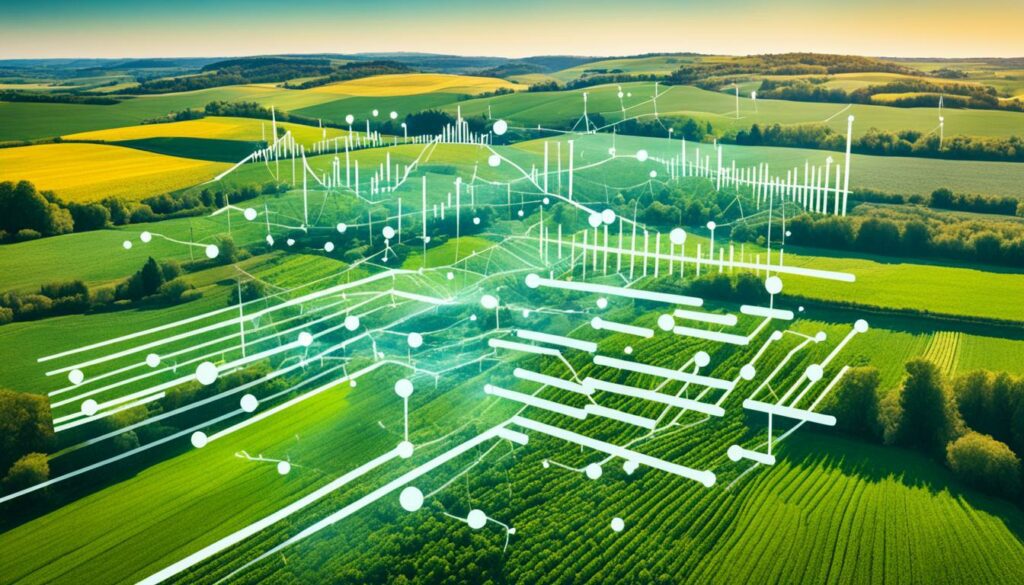
The sector is a major contributor to the world’s greenhouse gas emissions, at 21%. This poses a big environmental threat. Climate change also brings extreme weather, making it hard for farmers to plan their crops well.
Another big issue is the drop in honeybee numbers, especially in the U.S. Bees are vital for pollinating crops, so this decline affects food production. The sector also faces tough global competition, pushing companies to keep innovating.
Still, the sector sees many chances for growth. Technology like bee vectoring, drones, and robotics is changing how farming works. Companies like AeroFarms and Hello Tractor are leading with sustainable practices.
Focusing on sustainability brings new chances too. Projects supported by the World Bank in Latin America have boosted farmers’ incomes and water-wise agriculture. Innovations like drip irrigation and seaweed cattle feed are making a difference.
There are also big market opportunities in Africa and beyond. Diversifying into biofuels and agritourism can open up new revenue streams. This could make the sector more resilient against challenges.
| Key Challenges | Emerging Opportunities |
|---|---|
| Greenhouse Gas Emissions | Technological Advancements |
| Climate Change Impacts | Sustainability Initiatives |
| Fluctuating Crop Prices | Expansion in Emerging Markets |
| Declining Bee Populations | Diversification into Biofuels & Agritourism |
| Global Competition | Increased Efficiency Through Technology |
Overall, despite its challenges, the agribusiness sector offers great opportunities. By being innovative and sustainable, it can move forward. Success will come by adapting to new trends and ideas in farming. This is how the sector can make the most of its growth potential.
By 2050, the world’s population may reach 9.7 billion. At this pace, connected agriculture tech is seen as vital. It could boost the world’s economy by $500 billion before 2030 through smart farming methods. This shows how important these new solutions are.
Today, IoT in farming brings change to how agriculture works. It helps with on-the-spot checks and gathers facts. Though farms have been a bit slow to go digital, a quarter in the U.S. use smart tools. These tools, working on 3G and 4G, help with basics like watching crops and animals. They open doors for even more helpful tools in the future.
By 2030, around 80% of rural areas worldwide will have top-level connectivity (not including Africa). This set up will bring in high-tech answers we need for better farming.
Using data quickly helps farms a lot. It lets farmers act fast on things like water use, stopping pests, and adding fertilisers. This cuts down on waste and uses resources better. For example, farms indoors use 70% less water than usual. And all because of data use.
Approximately 9.9% of the world’s population still suffers from hunger, highlighting the urgent need for efficient food production systems.
By 2030, the world might have 40% less water than needed. So, smart farming to save water will be a must. Plus, smart devices can help farms damaged by overuse to grow food again. This way, we can use our land well.
| Aspect | Details |
|---|---|
| Forecasted Global Population (2050) | 9.7 billion |
| Projected Increase in Food Demand | 70% |
| Global GDP Contribution by 2030 | $500 billion |
| Expected Coverage of Advanced Connectivity | 80% of rural areas |
| Water Usage Reduction with Indoor Vertical Farming | 70% |
In conclusion, connected tech and IoT in farming are key in meeting future food needs. They bring more than just extra produce. They help the planet too. This offers hope for a greener future in farming.
The agricultural world checks quarterly prices to guess what future prices might be. This is done by looking at past data and using services to predict. It’s how we understand and plan for the unpredictable world of farming prices.
To know what prices might do next, we must first look back. Quarterly data on many different types of crops and animals gives us a big picture look at the markets. The Agriculture Pricing and Purchasing service gives price guesses for 38 things we grow or raise until 2020.
They also have forecasts to 2025 for 19 types of crops in 63 areas. The US Agriculture Service helps by giving future guesses for 30 types of plants and animals till 2025. This info is key to understand the ups and downs of the farming market.
Giving a good guess on prices involves a lot of looking back and looking around now. The Global Livestock Service makes predictions on meat animals in 35 big areas until 2025.
The US Agriculture Service, on the other hand, looks at state crops and says how much they might be worth till 2025. This is crucial data for anyone in farming or buying and selling foods.
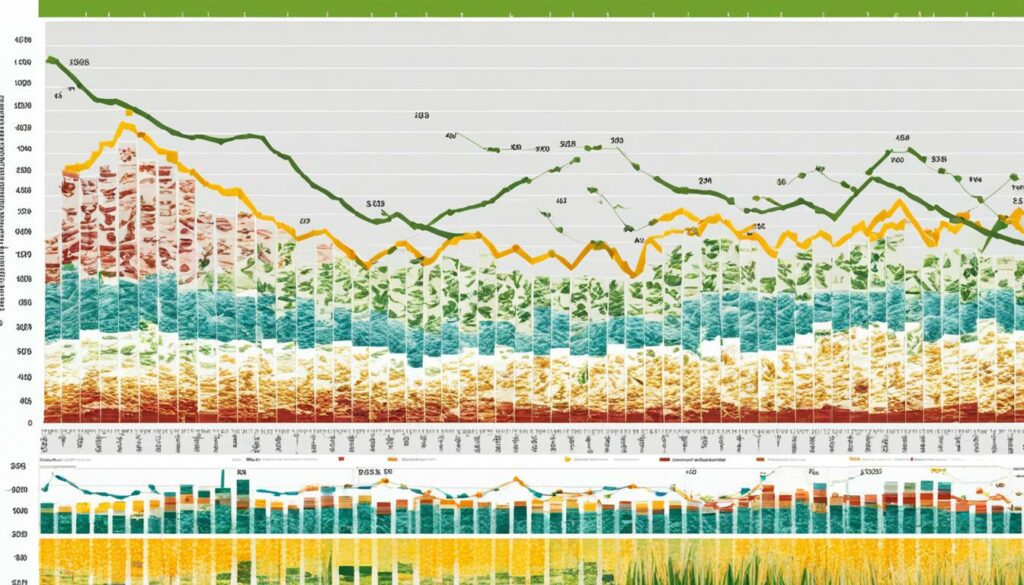
Hitting the right note with guesses helps everyone make smarter choices. They do this by looking really closely at how much land will be used for certain crops ahead of time. They can also guess what some crops’ costs will be in many countries ahead of time, till 2020.
| Forecast Service | Coverage | Timeframe |
|---|---|---|
| Agriculture Pricing and Purchasing service | 38 commodities | Quarterly to 2020 |
| US Agriculture Service | 30 crop and livestock categories | Quarterly to 2025 |
| Global Crops Service | 19 crops in 63 regions | Historical and Quarterly to 2025 |
| Global Livestock Service | Beef, Pork, Broiler industries | Quarterly to 2025 |
| US State 20 Principal Crops Acreage Service | 20 major US crops | Quarterly to 2025 |
| Global Crops Cost of Production Service | 14 selected crops in over 40 countries | Semi-annual to 2020 |
The forecast for the rural economy is key in understanding how it affects agriculture. Things like the income farmers make, what they spend, and the help they get from the government all matter. By looking closely at these, we can see how rural economic health and farming are tied together.
The economy’s condition has a big impact on the countryside and farming. For instance, in 2022, the farm income was quite high at $185.5 billion. But by 2024, it’s expected to go down to $116.1 billion. This is a big drop.
Similarly, the money farmers actually bring in, or cash farm income, will fall from $202.3 billion to $121.7 billion in 2024. This is because they’ll be getting less money for their products but spending more to produce them. Total cash receipts could drop by $21.2 billion.
At the same time, they will need to pay more for things like fuel and machinery, with total costs going up by $16.7 billion. The main reason for this problem is that the prices people pay for farm products are going down by $26.9 billion.
The government’s help is very important for farmers during tough times. In 2024, these direct payments might be about $10.2 billion. This is a bit less than before.
But, the money that goes towards programs to help the environment on farms is going up. It’s expected to be $4.0 billion in 2024. These programs aim to help farmers deal with nature’s challenges and changing markets better.
So, with these figures about the rural economy and farming, we see that having smart and flexible policies is really important.
| Year | Net Farm Income (Billion $) | Net Cash Farm Income (Billion $) | Total Cash Receipts (Billion $) | Direct Government Payments (Billion $) | Production Expenses (Billion $) |
|---|---|---|---|---|---|
| 2022 | $185.5 | $202.3 | $506.7 | $12.1 | $438.4 |
| 2023 | — | — | — | $12.1 | — |
| 2024 | $116.1 | $121.7 | $485.5 | $10.2 | $455.1 |
The COVID-19 pandemic caused big changes in agriculture markets around the world. In Bangladesh, a big part of the workforce, about 37.75%, works in farming. This helps generate a large part of the country’s income.The lockdown from March to May 2020 hit farmers hard. A study by BRAC found that farmers lost a huge sum of money. This loss deeply affected their lives.
The challenges in farming due to COVID-19 were significant. Most farmers and all fishers faced financial losses. The main problems were unfair prices, limited market hours, high costs, and not enough workers.The prices for poultry dropped by 44% with the closure of restaurants. The dairy industry also suffered, with demand falling by a third to over half. This reduced the agriculture sector’s ability to produce by 18%.
The pandemic also caused severe problems for dairy and poultry farms in Bangladesh. Millions of dollars were lost in milk production. Poultry businesses faced over a billion dollars in losses in just two weeks.The marketing system, which depends a lot on middlemen, also caused issues. It meant farmers did not get good prices for their crops, making their financial situation even worse.
On a global scale, COVID-19 did impact agriculture by reducing trade between 5% to 10%. However, the World Trade Organization noted less impact than predicted. This was due in part to strong government support.Despite the challenges, global agricultural trade actually grew by 3.5% in 2020. Factors like consistent food demand and efficient shipping helped. The future looks hopeful for agriculture markets, with smart strategies working to solve ongoing problems.
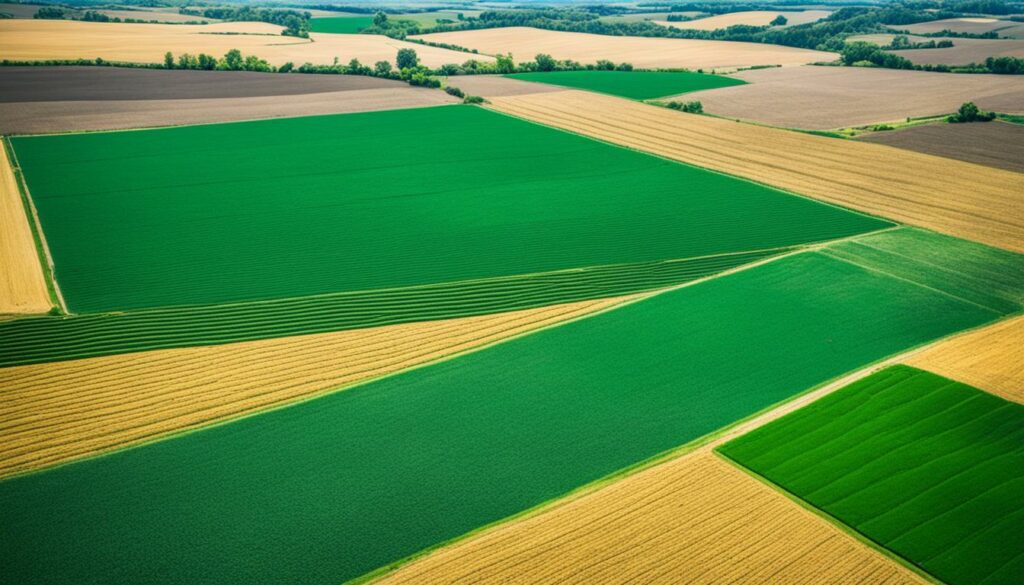
Wholesale prices and trade amounts were greatly affected by COVID-19. For example, wheat prices initially spiked in April but then stabilized thanks to government help. On the other hand, tomato prices dropped at times.Government support protected crops like wheat, while tomatoes and onions suffered. The impact was worsened by travel restrictions and lockdowns, affecting trade severely.
| Impact Category | Statistics |
|---|---|
| Agricultural GDP Contribution (Bangladesh) | 12.65% (128.57 million USD) |
| Financial Loss (Farmers) | 56,536 thousand cores BDT |
| Farmers Facing Financial Loss | 88% |
| Fishers Facing Financial Loss | 100% |
| Poultry Price Drop | 44% |
| Dairy Demand Drop | 33-60% |
| Loss in Milk Production | 6.7 million USD (12-15 million litres) |
| Poultry Industry Loss | 1.35 billion USD |
Looking into the agricultural market analysis, we see it’s backed by big investments and tech upgrades. Angola and Argentina are pushing for agricultural growth. They’ve approved many projects to support farmers and their families.
In Benin, new tech is helping over 300,000 farmers boost their produce. Bolivia and Brazil are also making big strides. They’re supporting many families and improving farm infrastructure.
Bhutan and Burkina Faso are seeing better farm results, with more products and healthier livestock. Meanwhile, the Central African Republic has more than doubled its local food production.
In Colombia, large areas are now farm-ready, and carbon emissions are lowering. Ethiopia is aiding millions of farmers to boost their earnings, which helps the agriculture industry stay strong.
Elsewhere, Grenada and Guinea are supporting their farmers well. They’ve seen significant increases in their crops and sales. This shows their agriculture is flourishing.
The future looks bright for farming. Top markets are expected to see significant growth in the next year. Areas like biostimulants and organic fertilisers are also projected to expand. These forecasts bode well for the agricultural market.
The market dynamics in agriculture are also backed by reliable data. Institutions like the Food and Agricultural Policy Research Institute offer valuable insights. Their reports on the agricultural market are key for decision-makers.
Agriculture is proving to be adaptable and strong. With a focus on tech and smart spending, it can keep growing. This shows how important and promising the agricultural sector is.
In the vast and varied global agriculture market, different regions shape how it works. Looking closely at each place shows us special trends and chances. For example, we see unique growth patterns in Asia-Pacific (APAC) and specific conditions in Europe, the Middle East, and Africa (EMEA).
North America leads in the agricultural field’s smart ideas. The United States and Canada are big on new farming tech and ways to live green. Companies like AeroFarms and Plenty are changing farming with vertical systems. This makes growth in this market steady.
The APAC area is growing fast, thanks to its big need for food and modern farming. Places like China, India, and Japan are using the latest in agri-tech. They’re big on methods like hydroponics and aeroponics. Now, companies like Gotham Greens are making their mark here.
Europe mixes old farm ways with new, green tech. Places like Germany, France, and the UK lead in smart, green farming. They care a lot about following strict rules and protecting nature. This makes a big impact on how the farming market works in Europe.

EMEA’s farming challenges bring chances for smart solutions. The dry Middle East is getting better at using water and growing more crops. Africa is using smart farming to fight hunger and grow more. Companies are working hard here to find new ways in farming.
South America shines in growing key crops and raising animals. Brazil and Argentina lead in selling their farm products. But, they also face issues like cutting down forests and changes in weather. Choices that help the environment are key for their future farming success.
Nowadays, knowing the latest in farm prices and purchasing trends is key. The farming world has seen big changes in what things like crops and animals sell for. For example, crop prices went up by 18% in 2020. Then, in 2021, they shot up another 14% and climbed by 8% more in 2022. Livestock prices also had an interesting time, dropping by 7% in 2020 but rising by 18% in 2021 and hitting a high in 2022. With prices moving so much, how farms manage their costs can really affect their profits.
Reducing costs in farming is all about planning well and using your resources smartly. New tech, like precision farming, is a big help. It lets farmers use detailed data to pick the best times to plant and the right way to use their resources. This means they can waste less and do a better job. Also, buying lots of seeds and fertiliser at once can save you a lot of money.
Getting the most from what you buy in farming means being careful about where you get your supplies from. Doing good research and checking out your suppliers can help get you good quality stuff at good prices. Look at what Cargill did. They used what they knew about the markets to make their buying better. This saved them a lot of money. Staying tuned to what the market demands, for instance, when California’s crops were worth over $33 billion in 2017, can help too. It makes your farm more competitive.
These strategies aren’t just about saving money or making more. They also aim to help farming stay strong and make money in the long run. In a world where things change a lot, with more people and more money, following these methods acts like a sturdy guide in the farming world.
The current agricultural market overview looks at the market itself. It checks out new tech, where products come from, and how society affects it. It’s all about being green and high-tech, with companies such as Plantagon and Indoor Harvest leading the way.
Today, agriculture is changing fast thanks to new tech. Things like precision farming and smart gadgets are making farms more efficient. AeroFarms and Green Sense Farms are at the forefront, using data to grow crops better.
There’s a big focus on ‘green’ farming now. This is because we’ve realised how farming can harm the planet. By farming in smarter, kinder ways, we can use the land for longer.
Crop prices don’t just depend on how many there are. They’re also affected by things like the weather, how they’re moved, and how much folks want them. Big issues in the world also have a say in this.
To guess how much crops will cost, experts look at old info and what’s going on now. They think about the market, the economy, and things happening in places like North America, APAC, and Europe. This helps them guess where prices might go up until 2025.
Companies leading in Intelligent Agriculture include Plantagon and AeroFarms. They’re at the front of the line for new farming tech and ideas.
SWOT and PESTLE studies give a deep look at what’s going on in farming. They show the good and bad, what’s changing, and what we’re up against. This helps everyone understand the market better.
The farm world is getting smarter, and that means big growth. By 2029, we expect this part of farming to really take off. New tech and the push for greener farming are key reasons.
Farming is going green, even with animals. We’re using smart ways to keep them healthy. Prices are changing a lot, depending on what people want and how we get it to them.
Experts look at what’s happening now and predict the cost of livestock goods. They study the market and say what they think will happen. Their words help us know what to expect.
The farm biz has its own set of troubles. Things like not enough resources, laws that keep changing, and how the market acts can be tough. But, using new ideas, reaching out more, and being high-tech can help.
The farm world’s future is looking bright. Green ways of farming, using smart tech, and finding new markets are all chances for growth.
Farms are getting smarter with the help of IoT. This means using smart sensors, machines that can think for themselves, and lots of data. It’s all about making farming better and easier.
Today, farms can change quickly because they use data right away. Knowing how the soil is doing, what the weather’s like, and more helps farmers make the best choices.
Through the years, we can see how farm things, like food, have gone up and down. These changes are because of how much people want them, the weather, and the world’s money scene. By understanding the past, we can guess what might come next.
By looking at old info, what’s happening now, and getting expert advice, we can guess the future prices of farm goods. This includes stuff happening all around the world, not just in one place.
Farm life is tied to big money issues like what things sell for, if people can easily buy and sell them, and how much countries invest in improving farmers’ lives. All these things can make or break farming in the countryside.
Governments help farms by offering money, building things that help farmers work better, paying for new ideas, and making it easier to sell farm stuff. These actions keep farming strong and growing.
The pandemic hurt how farms work by making it hard to find workers, messing up how things are usually done, and people not buying as much. But, farms are getting better and hoping to see good times again, with the help of some smart thinking and changes.
Market changes come from how much people want farm things, the new tech that’s making farming different, world changes, and the rules that show how farming should be done. These are the big things that make the farm world tick.
North America’s farm market is all about using the best tech, lots of money for new ideas, and making sure farming is kind to the environment. Recent info says it’s doing well and is likely to keep growing.
The APAC area is growing fast in farming because more people need food, there’s more tech being used, and governments are helping farmers do better. This is making the farm world in Asia-Pacific more important.
Europe’s farms are keen on being green and using high-tech. There are also many rules that help farming be better for the environment. These things are making farming in Europe strong and getting better.
The Middle East and Africa are working hard to farm smarter and be kinder to the planet. They’re using more tech, building better roads for getting farm stuff where it needs to go, and following green rules. Despite some tough times, farming in these places is looking up.
South America has a lot of land to grow things on. It’s also putting in more money in farming tech and selling a lot of farm things to other parts of the world. This shows that farming in South America has a bright future.
Using high-tech ways to farm, using less and getting more from what we have, choosing where we get what we need carefully, and knowing the market well can all help keep costs down in farming.
Getting the best deals, using smart ways to buy things, and making sure we work with the right people to get the best stuff can all help farming bring in better quality and value, as shown by Cargill’s success.